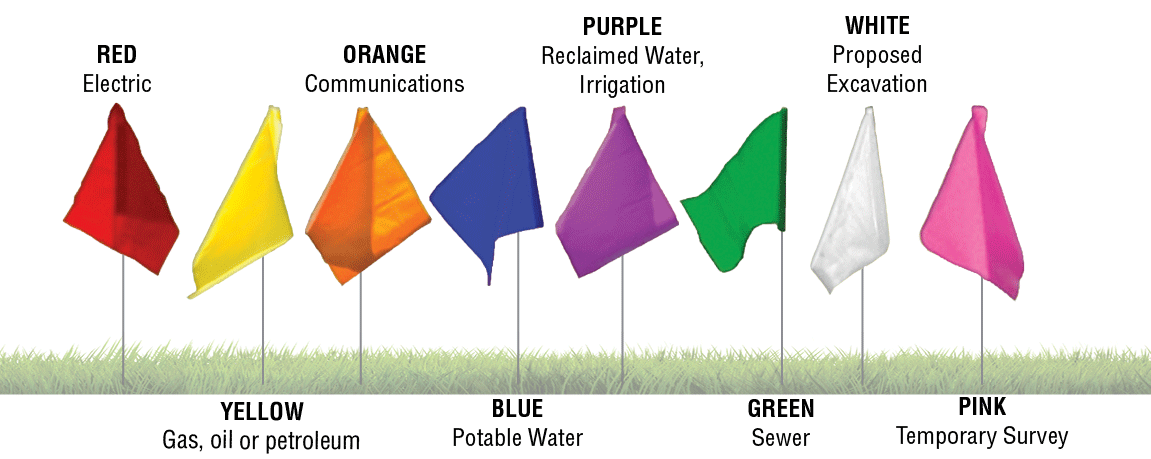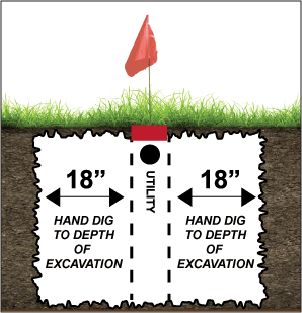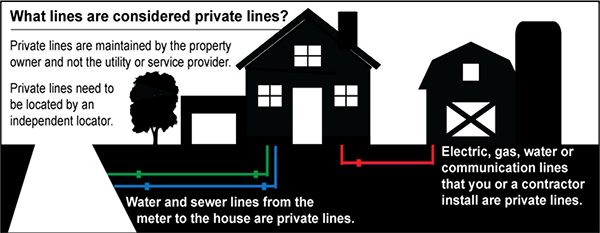Become a partner in damage prevention and follow these important steps when planning any type of project that involves digging, regardless of the project size or depth.
Once you have determined where you want to dig, pre-mark the area using white paint, stakes or flags. The Act requires excavators to pre-mark the area when practical. This allows member locators to understand the size and scope of your project.
According to the Illinois Commerce Commission One-Call Enforcement Staff, “when practical” is not a statement of convenience, but is used as it relates to scope. A verbal pre-mark in place of paint, stakes, or flags is allowed if a narrow and explicit distance and direction of the proposed work are provided.
Pre-Marking
Pre-marking is the process of marking the dig area with white paint and/or white flags prior to contacting JULIE. In winter months, black paint or flags may be used when snow is present. Pre-marking allows member locators to complete their work more efficiently and makes it easier for excavation crews to identify the dig area.
Pre-marking Tips
Now that you have scoped out your work area, the next step is submitting a locate request through JULIE.
Information needed
It’s easy…and it’s FREE. But first, have the following information handy to speed up the process:
Ways to submit a request
Two business days
You may not begin your excavation before the dig start date and time listed on the notice, even if all the underground utility facilities have been marked. State law requires your excavation project to begin within 14 calendar days of the issuance of your Dig Number.
Dig number

Ticket life
Holidays
While JULIE agents and online request options are available on JULIE recognized holidays, members usually have crews on call to handle emergencies only. Therefore, in addition to weekends, the following days are not included in the determination of the two business days:
If a holiday falls on a Saturday, the previous Friday is observed. If the holiday falls on a Sunday, the following Monday is observed.

After receiving notification from JULIE, member companies may use a combination of flags, stakes or paint as dig site and seasonal conditions warrant. If the approximate location of an underground utility facility is marked with paint, stakes or other physical means, the following color code is employed:
Other colors of flags or paint you may see at a dig site include white, which shows the extent of the excavation area and is used in pre-marking prior to making a locate request, or pink which indicates
a temporary survey.
Once the marks are placed, it is the responsibility of the excavator to maintain those marks.
Markings
Members’ locate staff are marking the approximate location of the underground utility facilities. “Approximate location” is a strip of land 17 at least 3 feet wide, but not wider than the width of the underground utility facility plus 1.5 feet on either side of the facility based upon the markings made by the owner or operator of the facility. To verify the location of the underground utility facility, employ hand or vacuum excavation methods to the depth of your proposed excavation and visually inspect the excavation while in progress until clear of the existing marked facility.
Cleared
If a JULIE member company has no underground utility facilities in the proposed area of the excavation, they are required by law to communicate this to the excavator by the requested dig start date and time on the notice. For Emergency Requests, notification should occur within two hours or by the date and time requested, whichever is later.
Notification can be done by:
Tolerance zone

Private Facilities
JULIE member companies only mark the underground utility facilities they operate and/or maintain. They do not mark private underground lines which are lines installed beyond the JULIE member company’s ownership. These lines are considered customer-owned or private lines.

Examples of private lines may include but are not limited to:
Water member companies mark the main lines in easements and right-of-ways and in most cases, lines to a water meter or curb valve, whichever is closest to the main line. However, they may not mark the water lines to and from a meter or curb valve to a home or building. Sewer member companies mark the main lines but may not mark any portion of a lateral service to a home or building. Check with your local water or sewer provider to determine their marking standards.
Electric member companies usually mark the lines to the meter at residential properties, but not those running to swimming pool pumps and heaters, irrigation systems or other buildings on the property. Commercial property owners should check with their electric company to determine if any or all of the electric lines will be marked by the electric company.
Private lines will be part of almost every job. Take time to survey the job site for signs of private lines:
Take a few moments to review these issues with the property owner prior to beginning your excavation, but keep in mind that previous property owners may have installed lines that the current owners don’t know about.
Do not dig until the buried lines are identified and marked. JULIE member companies DO NOT mark privately installed lines. These lines can be marked by hiring a private locator.
If Damage Occurs
Even the most cautious excavator or homeowner can occasionally cause damage to a buried line. If an underground utility facility is damaged or dislocated, state law requires that the person responsible for the
excavation or demolition immediately notify the affected utility and JULIE at 811 or 1 (800) 892-0123.
Please be prepared to give the following information to the JULIE agent:
JULIE’s agents may be able to assist with contact numbers for notifying JULIE member companies.
In the event of damage to an underground utility facility that results in the escape of a flammable, toxic, or corrosive gas or liquid, the person responsible for the excavation or demolition must:
DO NOT attempt to repair, clamp or constrict a damaged utility line unless under the direct supervision of the utility owner.
Cleanup of Job Site/Removal of Flags
When the job is complete, take the time to backfill properly. Remove large rocks, sharp objects, and large chunks to reduce the risk of damage while backfilling around underground utility facilities. All marking flags should be removed from the job site as the final step prior to leaving the area.